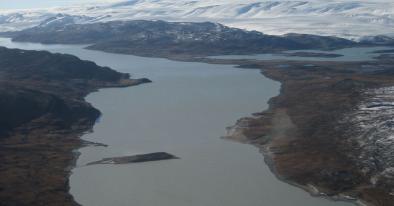Science Source
A sensitivity study of annual area change for Greenland ice sheet marine terminating outlet glaciers: 1999–2013
- States the mass flux from marine terminating glacier outlets from the Greenland ice sheet is a significant mass budget term, yet, glacier calving sensitivity to climate parameters is not well understood
- Measures the front area changes of 42 marine terminating Greenland outlet glaciers annually from 1999 to 2013 using optical satellite imagery
- Finds that 35 glaciers retreated, while seven remained stable
- Finds the average front position change was −240 m a−1 and the total rate of front area change was −114 km2 a−1
- Compares the yearly average area changes of all measured glaciers with interannual variations in sea surface temperature (SST), sea-ice concentration (SIC), surface melt, Northern Hemisphere (NH) surface air temperatures and the North Atlantic Oscillation (NAO) index
- Finds:
- (1) northwestern glaciers area change have a significant correlation with surface melt and NH land temperature variations;
- (2) southeastern glaciers have a significant correlation with local SST, SIC and NH temperatures; and
- (3) southwestern glaciers area change correlate significantly with local SST and NAO index. We conclude that a climate sensitivity signal emerges considering a population of glaciers
- Finds a significant correlation between the date of minimum extent and glacier latitude
Related Content
Science Source
| Geophysical Research Letters
Melting glaciers stimulate large summer phytoplankton blooms in southwest Greenland waters
Kevin R. Arrigo, Gert L. van Dijken, Renato M. Castelao et al
Science Source
| Geophysical Research Letters
Ice Core Records of West Greenland Melt and Climate Forcing
K. A. Graeter, E. C. Osterberg, D. G. Ferris et al
Science Source
| Science Advances
Abrupt shift in the observed runoff from the southwestern Greenland ice sheet
Andreas P. Ahlstrøm, Dorthe Petersen, Peter L. Langen et al
Headline

Dec 15, 2017 | Vox
Greenland's ice sheet is driving global sea level rise. One section is melting 80% faster.


